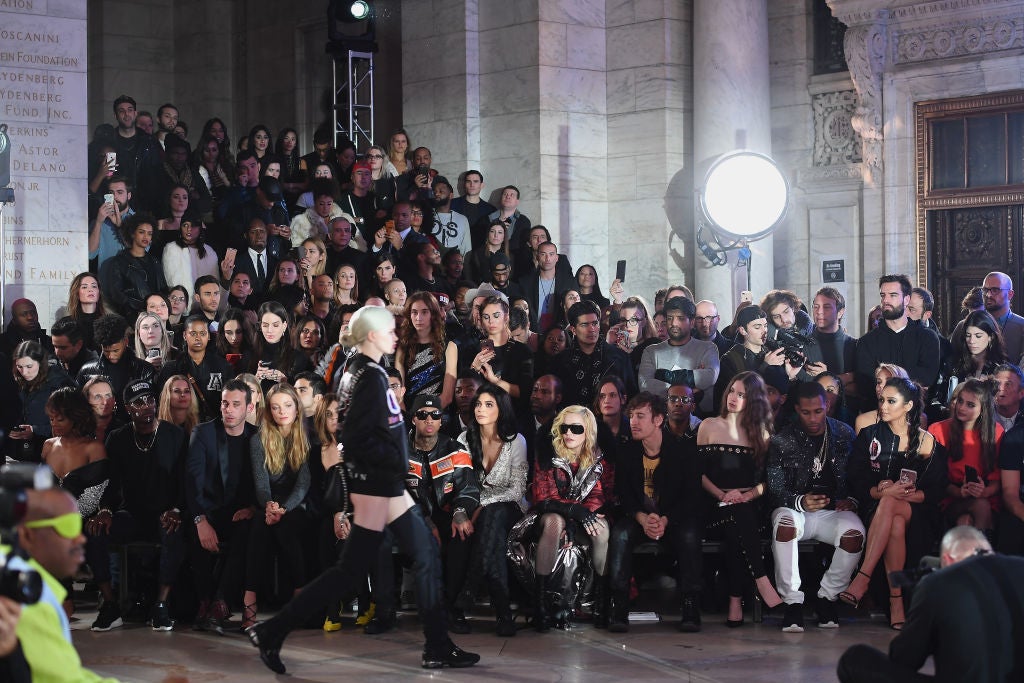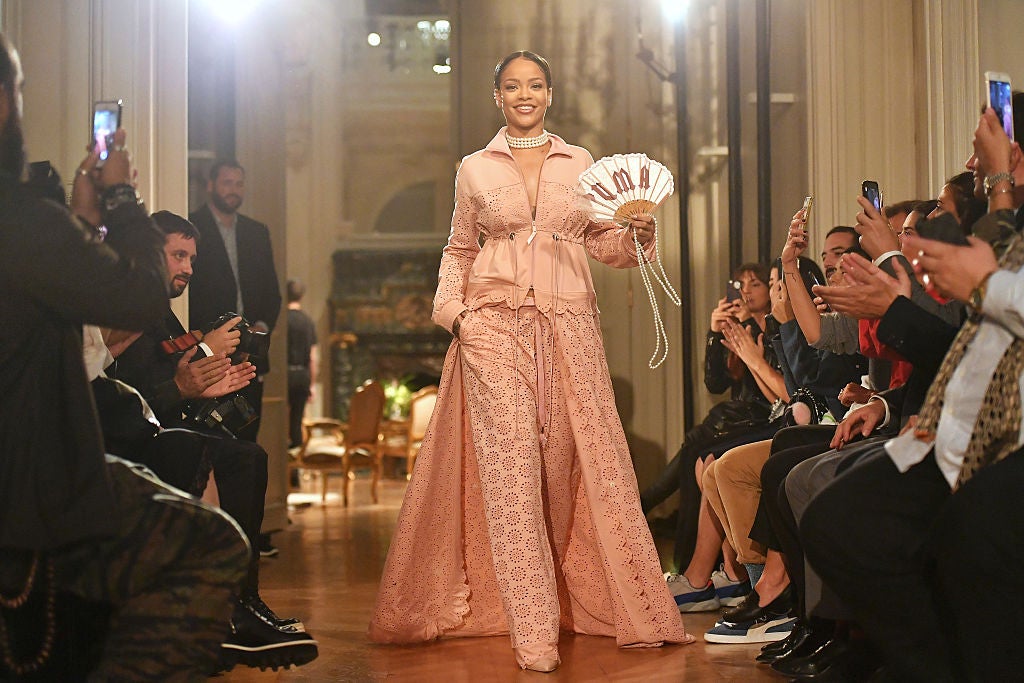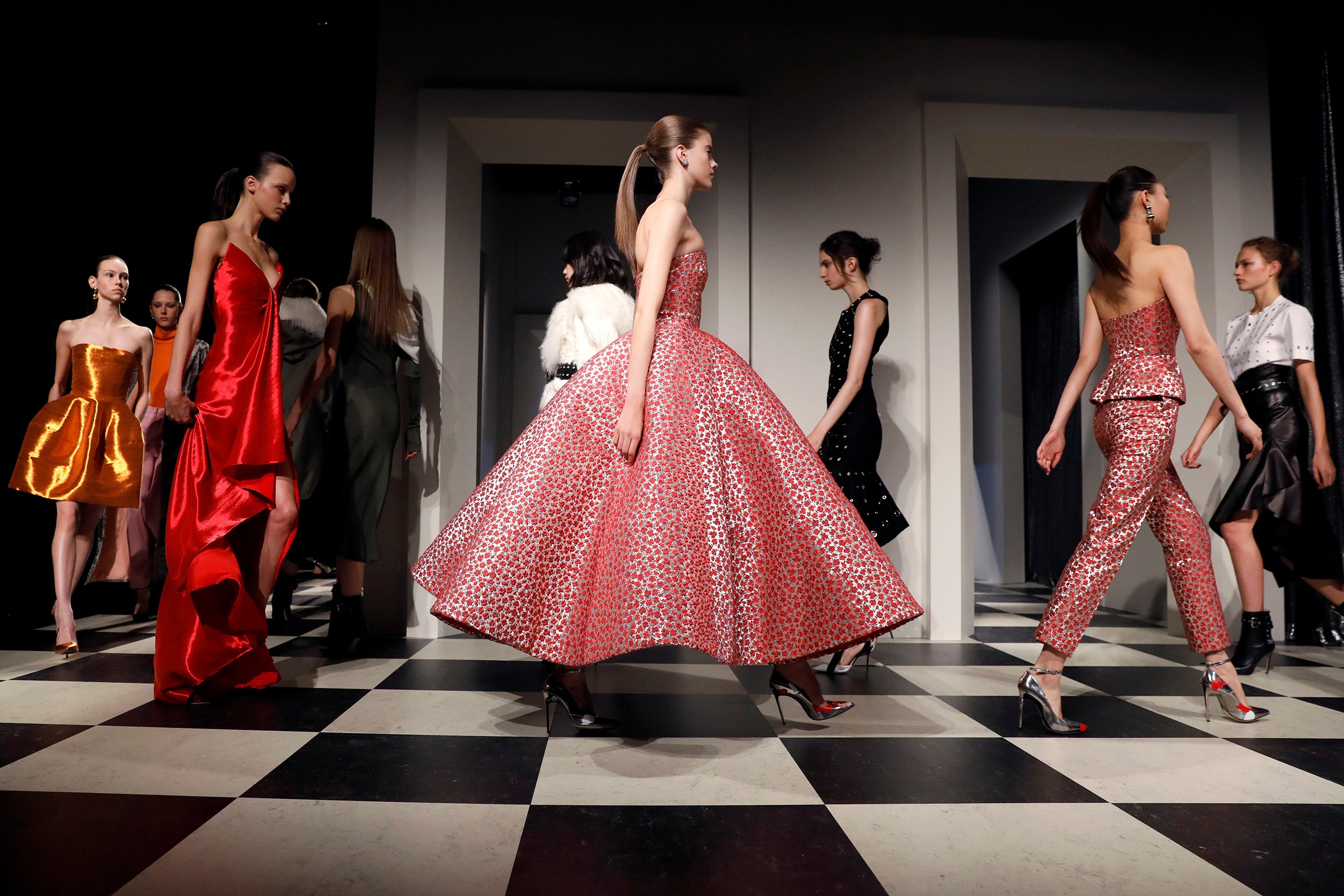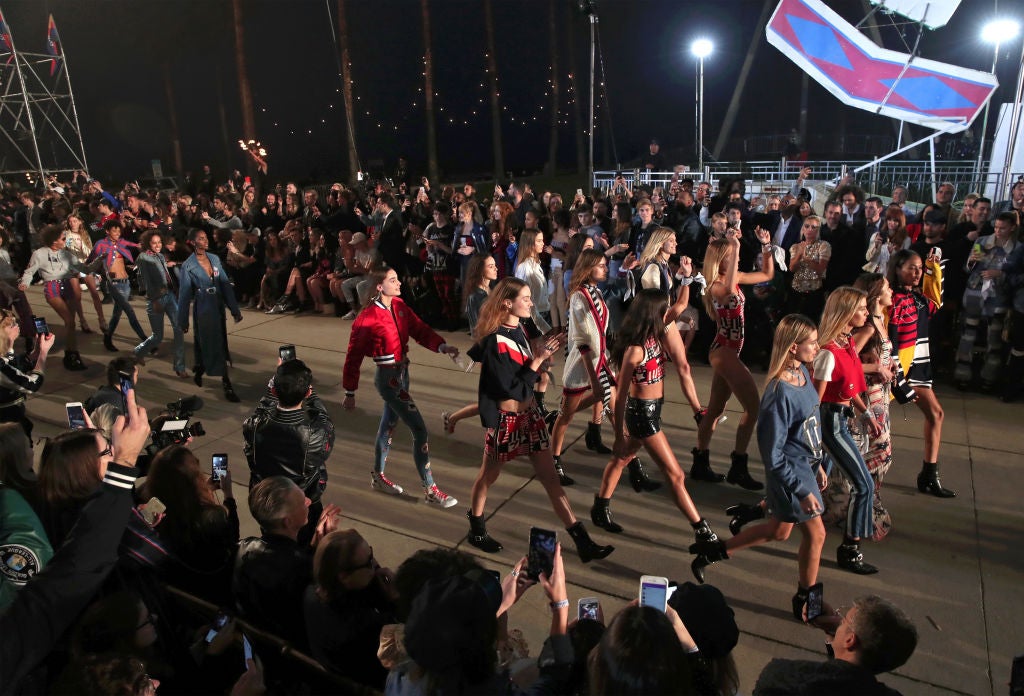Is it New York Fashion Week? Or is it Rihanna Inc.?
As some major designers decide not to show in New York, aesthetics face off against Instagram

Your support helps us to tell the story
From reproductive rights to climate change to Big Tech, The Independent is on the ground when the story is developing. Whether it's investigating the financials of Elon Musk's pro-Trump PAC or producing our latest documentary, 'The A Word', which shines a light on the American women fighting for reproductive rights, we know how important it is to parse out the facts from the messaging.
At such a critical moment in US history, we need reporters on the ground. Your donation allows us to keep sending journalists to speak to both sides of the story.
The Independent is trusted by Americans across the entire political spectrum. And unlike many other quality news outlets, we choose not to lock Americans out of our reporting and analysis with paywalls. We believe quality journalism should be available to everyone, paid for by those who can afford it.
Your support makes all the difference.Is New York Fashion Week, which officially began on Thursday but actually began Wednesday (thank you, Tom Ford), a dead duck? Is it a sinking ship, in the soup, up the creek? Is it – gasp! – over?
Not “over” in the literal sense, of course. There are more than 130 shows on the schedule. But “over” in the substantive sense. Over as a power player in a global system that puts a premium on showcasing clothes that redefine how women present themselves. Over as we know it. Forget whether or not suits are back; this is the existential question underpinning the fashion season.
The debate has been raging all summer, ever since Rodarte and Proenza Schouler decamped to Paris for couture in July, and Thom Browne announced he would move to Paris and show during ready-to-wear, and then Joseph Altuzarra said “me too”, and even Lacoste said it was likewise heading back to its city of birth, and then Narciso Rodriguez cancelled his show in favour of individual presentations, and Rag & Bone decided to do its own thing, and ... well, you get the point.
According to the laws of fashion (hemlines that go up must come down; minimalism will have an equal and opposite maximalist reaction), one example of anything is a fluke, two is a coincidence, and three is a trend. This is way past trend.
The basic issue is simple: despite all the allotted catwalk time, there are a handful of names that matter in terms of broad influence and renown.
In the beginning there were three – Ralph, Calvin, Donna – the brands that became synonymous with upwardly mobile, female-first sportswear.

They were joined by Carolina (Herrera) and Oscar (de la Renta). Later came Marc (Jacobs) and Michael (Kors) and Narciso (Rodriguez), the three Americans chosen in the 1990s to help revive major French houses (Louis Vuitton, Céline and Loewe) and hence crowned the Next Big Things. After them came another generation championed by the CFDA/Vogue Fashion Fund in the post-9/11 world: Proenza Schouler, Rag & Bone, Rodarte, Altuzarra, Thom Browne – all newer names with international magnetism.
Yet it is exactly that latter group of success stories who are decamping for alternate shores. When the exodus began, I talked to Steven Kolb, chief executive of the Council of Fashion Designers of America, about whether he was concerned, and the message was: absolutely not. It was a personal step for each brand based on its business needs, not a vote against New York.
And besides, to have the Paris seal of approval – to have American brands be good enough to show in Paris – should be seen as a badge of honour for New York.
It is true that all the designers who left New York Fashion Week have done so for individual reasons: because it’s better for deliveries to show in July; because they need to reach international buyers; because their parent company is French.
But it should be pointed out that no one who shows in Paris, London or Milan seems to feel a need to experiment in quite the same way. Indeed, the Paris schedule is exploding, even without that impulse. And to a certain extent, that simply underscores the stereotype that Paris is a more fertile place for aesthetic growth than New York, one that focuses on creativity as opposed to – sniff! – mere clothes.
It’s an idea reinforced by the fact that into the vacuum left by the departures comes a flood of pop culture powers led by Rihanna, returning after two seasons in Paris with three major fashion week moments: the introduction of her first makeup line (Fenty Beauty!); the Fenty Puma show; and, finally, what may be the most buzzed-about blowout party of the week. She is going to be such a dominant presence, one might be forgiven for thinking it’s actually Rihanna New York Fashion Week.
Then there’s Philipp Plein, the German PT Barnum of fashion, who will hold his second extravaganza in New York, complete with Dita Von Teese and Future. (Last season he took over a public library with living Statues of Liberty and a performance by the Kills, which may give you an idea of what to expect.) And Desigual, the Spanish brand, whose show is being orchestrated by Jean-Paul Goude and choreographer Ryan Heffington, of Sia’s “Chandelier” video fame – who is also working with Opening Ceremony and director Spike Jonze on another performance, which will be open to ticket holders from general public.

There will be a pop-up store featuring designer-made New York Fashion Week T-shirts, masterminded by WME/IMG, the sports and entertainment behemoth that administers the largest group of shows. Which has also introduced, for its corporate clients and high-net-worth consumers, the option to buy NYFW: The Experience, a behind-the-scenes opportunity to … well, experience the collections.
As a result, the balance of power seems to be shifting from aesthetic influencers to Instagram influencers. From fashion to fashertainment.
If you measure success during shows simply by viewership, by clicks and buzz, that’s probably absolutely fine. More people may be watching more catwalks. But if you measure success by the ability to bring decision makers to the city because they have to see – for themselves, not through a screen – the way a garment moves on the body, how it can resonate in the memory and change the way an individual may dress so that consumers look to this country for leadership, it might not be.
Insiders are lining up in opposing camps: those who see a crisis and those who roll their eyes at the angst. “I’m really positive about what’s happening,” said Catherine Bennett, senior vice president and managing director for fashion of WME/IMG. “There’s never been a time before when people are so open to trying new things and doing different things.”
And before you dismiss this as an industry-only problem, know this: the New York City economy has almost $900m (£690m) a year riding on the outcome. There’s a reason Carolyn B Maloney, representative for New York’s 12th congressional district, has held a series of news conferences detailing the value of fashion week (note: fashion week, not fashion) to the city. Its contribution to the bottom line – in hotels, car services, restaurants, florists, hairdressers and the like – is enormous.
No one is questioning whether American fashion is OK. It’s doing just fine, retail worries notwithstanding. New brands are born seemingly every FIT and Parsons graduation month. But this particular expression of fashion, the one that represents the soul of American fashion in the global imagination, is a different story.
There are still tent-pole names: Calvin Klein, currently having a renaissance under Raf Simons (although the fact that Simons won both the menswear and womanswear CFDA designer of the year awards in June underscores the dearth of competition); Ralph Lauren, who has seized the moment to export everyone to Bedford, New York, for his 50th-anniversary show; Oscar de la Renta, where designers Fernando Garcia and Laura Kim are drawing attention. Ford will make his return to New York after a season off, and Derek Lam is coming back to the catwalk.
But Sebastian Manes, the buying director of Selfridges in London, told me earlier this summer that Thom Browne was one of the main reasons he came to New York. Now that reason has gone. Alix Morabito, fashion editor of Galeries Lafayette, which will be sending a smaller team to New York this season, said that between the brands that had left the schedule and the rise of see now/buy now, the city had become “less attractive from the buyer side”.

Fashion is a global business, divided more by psychographics than by geography. And in the map of the mind that is the fashion system, New York has lost its identity.
Brian Phillips, president of the creative agency Black Frame, said that the moves create an opening for smaller brands to make a bigger impact, and it is possible that one extraordinary brand could break through and change it all. (The fashion hive mind can turn on a dime.) The streetwear scene is still bopping along, though it is unclear whether streetwear needs to be seen in person or if the small screen will suffice.
More interesting, the CFDA has teamed up with the American Civil Liberties Union (along with Planned Parenthood, which it worked with last year) to create runway events demonstrating support of the nonprofits’ causes; and WME/IMG is giving part of the profits from its shop to Unicef, and encouraging models to wear T-shirts between shows designed by Prabal Gurung that read: “Model Citizen”.
“We want to be on the front line, not the sidelines, to boldly fight to protect our precious rights and freedoms,” Kolb said in a news release. Fashion is at its essence about identity politics, but brands have traditionally shied away from overt positioning. New York could assume that mantle of leadership, with every brand interpreting it in its own way.
But out of the cacophony needs to come a core of consensus. Otherwise it risks the worst look of all: irrelevance. Accessorised by parochialism.
What else to look for this season
New York may be in the hot seat, but that does not mean there isn’t action in the other three fashion month cities. Here’s what you need to know.
London
Also jumping to Europe is Tommy Hilfiger, who will take his #TommyNow interactive party to London (along with Gigi Hadid). Emporio Armani is moving to London as well; ditto Nicopanda, the brand started by Nicola Formichetti, Lady Gaga’s former stylist and the artistic director of Diesel. It is one-upping every other see now/buy now brand by teaming up with Amazon to guarantee delivery of some runway pieces in certain territories in under two hours. Yes: you watch the show and order on the app. It gives new meaning to immediate gratification.
Milan
After a season away, Roberto Cavalli, known for its sexy rock chick vibe, is back on the schedule under designer Paul Surridge, a British talent known primarily for his menswear. Also new to the schedule are Lucie and Luke Meier, a husband-and-wife team who are the creative directors at Jil Sander and hail from Dior and OAMC by way of Supreme, respectively.
Missing from the schedule: Pucci, designer-less since the decision to part ways with Massimo Giorgetti in April.
Paris
Thom Browne and Altuzarra will not be the only shows to watch in Paris this season. Three major debuts are taking place. At Givenchy, Clare Waight Keller, the brand’s first female artistic director, will introduce her dual-gender vision and prove her aesthetic well runs deeper than the boho chic she created for six years at Chloé, where Natacha Ramsay-Levi will take centre stage for the first time in her career. Ramsay-Levi is the former right hand of Nicolas Ghesquière (first at Balenciaga, later at Louis Vuitton).
And at the beleaguered brand also known as Lanvin, Olivier Lapidus, son of Ted and peripatetic design name (he has done stints in Japan and China, and moved between fashion, housewares and hotel design), will become the third creative director in two years.
All that excitement may go by the wayside, however, if Brigitte Macron makes a front row appearance at either Vuitton or Dior, the two brands shaping up to be staples of her wardrobe in the Élysée.
© New York Times
Join our commenting forum
Join thought-provoking conversations, follow other Independent readers and see their replies
Comments